For a contemporary artist is somewhat complex to come up with an exceptional way of personal expression likened to experimental forms, taking into account how much the art world has both branched out and enhanced. Commenting on Antioquia-born artist Libia Posada takes us right into that paradox that revs up a whole lot more when is lived by a woman with a two-pronged condition: a physician and an artist. But her work does not just zero in on the simple usage of art mechanisms with a view to represent her life experiences as a doctor, but rather –and above all– in a bid to create a hybrid space run through by the metaphors of disease and cure from social and cultural dimensions, deploying a vision and a compensation of those life experiences that are far subtler for not being within the reach of the common experience. For being the upshot of that double condition, they are additionally granted the power of zooming out from the micro world, of getting closer to relationships in their interconnections, to the causes as construed through the effects, putting them on display from a different perspective. Two orders are mandatory in the assortment of her works: the relation between the public and the personal, and the esthetic function that the space her artworks are contained in must fulfill. Both elements saunter their way through photography, drawing, interactive objects, installations, performances or works in progress, thus rubbing out the limit between what we know as patient calls, labs or nursery, and the gallery in which the traditional body images and their healing possibilities come down to their minimal expression. The public issue is addressed through artworks in the making that bring up the thorniest problems within the Colombian society. In the artistic framework of her country, this social sense of the art is achieved through a practice that stands very close to the Relational Esthetics theory1 and moves away from the creative forms that grow roots in the traditional concepts of art. However, the most striking element of her proximity to this practice lies in the fact that her artworks do not fit exclusively in the “relationship” as an artistic building resource because personal or social links whereby relations evolve are a cover-up that, once is inspired in reality, boost up the senses by creating highly evocating appearances. Proposal that rest on collective participation as a way of whipping her artworks into shape bears this out. For instance, the “Post-traumatic Syndrome” piece (2003-2008) consists of taking 5,000 polls in a very diverse public and through which the public is asked about the emotional and psychological aftereffects left by the “conflict.” At the same time, in the “Clinical Evidence” project (2006), the artist gathered 50 women who had endured domestic violence by the hands of their spouses or relatives, taking pictures of the violence signs on their bodies. In a different course of action, creations that favor the topic of diseases and their healing ways, relying on personal information and the sensitivity to turn social facts into artworks that depict the combination of social hardships, illnesses and psychological disorders also stand out. Works –some of them in progress– that incarnate the terrible experience of the physical pain, chiefly if it also becomes spiritual pain, that hard life dimension in which somebody turns into someone else. Her roughly 20 personal exhibits verge on that dilemma, appealing to an array of formal resources that set up a creative process that seems to get tangled up in itself. The topic of domestic violence or physical mutilations as a result of social conflicts becomes a part of the clinical space, through esthetics that makes it a silent witness of narrations deployed by the artist. This creative stance has allowed her to accomplish highly consistent stories, not only for the strength of the contents, but also for the ability of the space used by her to make them fit in. Installations like Checkup Ward (2000), Acute Respiratory Therapy (2003) and Rehabilitation Handbook, unveiled at the eighth edition of the Havana Biennial in 2003, bring us closer to the different perspectives the artist banks on for the use of clinical space. On her latest exposition, Libia explains how she leys herself out “around the body modified by the conflict and questions the social innards of modification, reparation and concealment medicine is no doubt a part of.” A poetry that goes deep into the inner imaging of the body, it discerns it to show its intimacy and paves the ways to achieve the perfect balance it’s made up of. A very particular matrix on the domestic violence issue is clearly found in the Clinical Evidence: Port-traits (2007). In this case, the artist made an intervention in the permanent collection at the Historic Museum of Medellin and she didn’t have the slightest idea of how much hard she was going to rock the historic foundations of the portrait concept. This exhibit consisted of a group of photographs that were supposed to replace the original artworks in the museum. Imitating the pose, the costume and the times when those works were created, spectators can make out the faces of ill-treated women, victims of domestic or social violence. Thus, a relationship between the complacency of the romantic portrait that usually takes center stage in museum halls and the terrible aftereffects of physical abuse was established, two overlapping vision that eventually alter the spectator’s visual stability, taking him or her to the realm of confrontations on a reality that is willingly ignored every so often. A smart game of roles that pays no respect to spaces or meanings in its effort to share this field of history through very close and updated images. Libia has set out to imagine and flesh out one of the most painful sides of Colombia’s reality: violence. Years that focus on social displacements, violation of rights, social and personal aggressions are all transcribed by means of prostheses, clutches and images that paint a crystal-clear picture of that reality. Simulation is one of the most concurrent topics since the medical issue is nothing but a trap set to bring the social background to the front –even though it’s projected through personal experiences to cash in on the information the spectator has on that particular topic. In her installations, she creates ambiences that melt into the medical treatments to some diseases, thus building semi-real scenarios in which the immaculate white plays a major role. The medical ward is impeccable, cold and aseptic, depending on the nature of the healing process it’s characterized by. However, the diadems of artistic imagination are the ones that truly put a different spin on the artwork by turning it into a memory of intense and painful prints, or just into a space to share life experiences in. From a different side, several series focusing on brain representations, the search of a more intimate experience, closer inner visions of the human body make their way through. Taking into account that the brain is by far the most complex and incomprehensible biological organization human knowledge has been faced to, she tries to represent it from a variety a perspectives, turning it into the mesh of all networks that sail into hazy spaces, with no edges and no boundaries. On the quest for an approach to her possible appearance, in the Post-Traumatic Syndrome exhibit (2003-2008), the artist displayed an assortment of artworks made of stitch thread and bandage on paper in an effort to broach the human nervous system and the possible relations between anatomy and physical aggression. By making use of these materials she came up with pieces that simulate heads emerging from an energy source, featuring silent blasts that send waves far beyond its boundaries. In the same breath, the Neurographs series (2005-2007) depicts drawings also linked to the human nervous system, like a collective body that works a symbiosis of both the personal and social sides. Another bandaged piece resembles the figure; others dominate abstraction and make up the cartography of that system where physical identity gets lost –though the contextual information of the space taken by each and every nerve brings to mind a humongous, internally-split galaxy. At the same time, in the Gray Matter exhibit (2009) the gallery transforms itself into an immaculate ward that holds pieces representing the delicate brain threads –we never notice where they either begin or end– that mislead us with their never-ending, traceless intertwining routes. But this time around formal beauty pops up from within. Figuration is intuited by the title of the piece rather than by any clear reference to its look. The different perspectives the brain can be looked at through an X-ray sheet are hidden as the artist pays more heed to the real movement than to the paused resting of a medical image. She intuits the beat of the brain energy that, even though unseen to the human eye, can mislead us with its metaphor: thin threads spliced together that abstracts the referent and lets the eyesight flow, slide and dance through the minimum spaces that splicing leaves behind. In the course of a few years, Libia has managed to piece together a poetic message in which a number of actions energize the public space, featuring artworks in progress that refer to social research, interactive works that talk with some of Colombia’s decisive social areas. They stand for an array of proposals –from the white space of the gallery– through which visual synthesis elbows its way, the same visual synthesis that wonders whether it’s possible to build truth-foretelling scientific models that wait endlessly for others to sit them in, depending on what beauty dictates. Science is laid bare in the face of image. She doesn’t need a logic that can explain its functional structure. The contrasting thin threads on the white wall are the best certainty there is. And though they seem to vanish into thin air and portray unreality, they do come closer to the perpetual flowing of thoughts that will always be beaten by life itself –no matter how fast it might go.
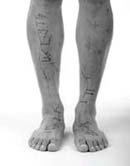
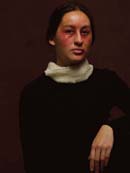
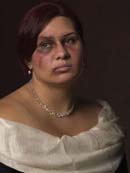
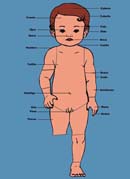
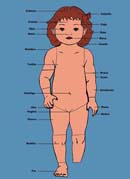
Related Publications

How Harumi Yamaguchi invented the modern woman in Japan
March 16, 2022












